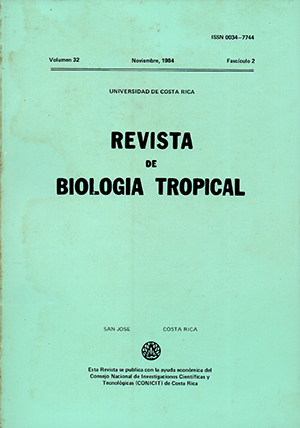Abstract
The reproductive cycle of the insectivorous bat, Pterollonotus parnellii mexicanus in a semi-arid tropical environment in Mexico is seasonally monoestrous. Copulation takes place in January, gestation is from February to the last half of May, and young are born around the first half of June, when the rainy season has begun and flies are abundant. The embryos were found 96.2% of the time in the right horn of the bihorned uterus, so a dextral asymetry with both ovaries functional is recognized. Males are active throughout the year, but epididymal mature spermatozoa are found only in Decenber, January and February. The accesory glands are markedly hypertrofied in December and January. Testes vary in length, but to contain mature spermatozoa, they must be at least 3 mm long during the copulation season.References
Asdell, A. S. 1964. Patterns of Mammalian Reproduction. 2d ed. Ithaca. Cornell University Press. xi. +670 p.
Bateman, G. C. & I. A. Vaughan, 1974. Nightly activities of Mormoopid bats. J. Mamm., 55: 45-65.
Bourliere, F. 1973. The comparative ecology of rain forest mammals in Africa and Tropical America: some introductory remarks, p. 279-292. In B. T. Meggers, E.S. Ayensu, & W. D. Duckworth (eds.). Tropical forest ecosystems in Africa and South America. Smithsonian Institution Press.
Brenner, F. J. 1968. A three year study of two breeding colonies of the big brown bat, Eptesicus fuscus. J. Mamm., 49: 775-778.
Davis, W. B., M. D. Hassell, & M. J. Harvey. 1965. Maternity colonies of the bat Myotis l. lucifugus in Kentucky. Amer. Mid. Nat., 73: 161-165.
Fleming, T.H., E. T. Hooper, & D. E. Wilson, 1972. Three Central American bat communities: structure, reproductive cycles, and movement patterns. Ecology, 53: 555-569.
Goodwin, P. E. 1970. The ecology of Jamaican bats. J. Mamm., 51: 571-579.
Howell, D. J., & D. Burch. 1974. Food habits of some Costa Rican bats. Rev. 8io1. Trop., 21: 281-294.
Humphrey, S. R., 1975. Nursery roosts and community diversity of nearctic bats. J. Mamm., 56: 321-346.
Janzen, D. H., & T. W. Schoener. 1968. Differences in insect abundance and diversity between wetter and drier sites during a tropical dry season. Ecology, 49: 98-110.
Krutzsch, P. H. 1979. Male reproductive patterns in nonhibernating bats. J. Reprod. Fert., 56: 333-344.
Kunz, T. H. 1973. Population studies of the cave bat (Myotir velifer): reproduction, growth and development. Oceas. Pap. Mus. Nat. Hist., Univ. Kansas, 15, 1-43.
Kunz, T. H. 1974. Reproduction, growth and mortality of the vespertilionid bat, Eptesicus fuscus in Kansas. J. Mamm., 55: 1-13.
McNab. B. K. 1976. Seasonal fat reserves of hats in two tropical environments. Ecology, 57: 332-338.
Migula, P. 1969. Bioenergetics of pregnancy and lactation in European common vales. Acta Theriol., 14, 167-169.
Mills, R. S. G. W. Barrett, & M. P. Farrell, 1975. Population dynamics of the big brown bat (Eptesicus fuscus) in Southwestern Ohio. J. Mamm., 56, 591-604.
Novick, A. 1963. Orientation in neotropical bats II. Phyllostomatidae and Desmodontidae. J. Mamm., 44: 44-56.
Rzedowski, J., 1978. La vegetación de México. Limusa, México, 432 p.
Sampedro, J. A., O. Torres, & A. Valdés de la Osa. 1977. Observaciones ecológicas y etológicas en dos especies de murciélagos dominantes en las cuevas calientes de Cuba. Poeyana Inst. Zool. Acad. Cienc. Cuba, 160: 1-18.
Studier. E. H., V. L. Lysengen, & M. J. O'Farrell, 1973. Biology of Myotis thysanodes and M. lucifugus (Chiroptera: Vespertilionidae) II: Bioenergetics and pregnancy and lactation. Comp. Biochem. Physiol. A Comp. Physiol., 44: 467-471.
Villa, R. B. 1967. Los murciélagos de México: su importancia en la economía y la salubridad. Su clasificación sistemática. Inst. Biol., UNAM, xvi +491 p.
Wilson, D. E. 1973. Reproduction in neotropical bats. Period. Biol., 75: 215-217.
Wilson, D. E., & E. L. Tyson. 1971. Spermatogenesis in some neotropical species of Myotis. J. Mamm., 52, 420-426.
Wimsatt, W. A. 1979. Reproductive asymmetry and unilateral pregnancy in Chiroptera. J. Reprod. Fert., 56, 345-357.
##plugins.facebook.comentarios##

This work is licensed under a Creative Commons Attribution 4.0 International License.
Copyright (c) 1984 Revista de Biología Tropical


